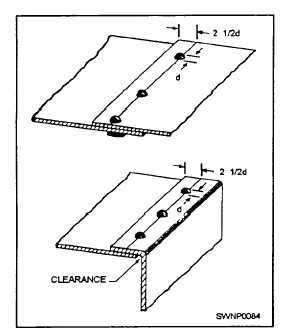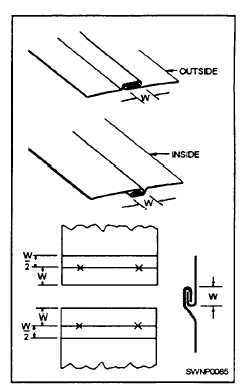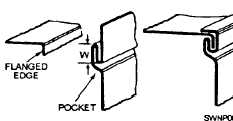
Figure 2-66. - Lap seams

Figure 2-67. - Layout of lap seams for riveting.
GROOVED SEAMS are useful in the fabrication of cylindrical shapes. There are two types of grooved seams-the outside grooved seam and the inside grooved seam (fig. 2-68). The allowance for a grooved seam is three times the width (W in fig. 2-68) of the lock, one half of this amount being added to each edge. For example, if you are to have a 1/4-inch grooved seam, 3 x 1/4 = 3/4 inch, or the total allowance; 1/2 of 3/4 inch = 3/8 inch, or the allowance that you are to add to each edge.
The PITTSBURGH LOCK SEAM (fig. 2-69) is a comer lock seam. Figure 2-69 shows a cross section of the two pieces of metal to be joined and a cross section of the finished seam. This seam is used as a lengthwise seam at comers of square and rectangular pipes and elbows as well as fittings and ducts. This seam can be made in a brake but it has proved to be so universal in use that special forming machines have been designed and are available. It appears to be quite complicated, but like lap and grooved seams, it

Figure 2-68. - Grooved seams

Figure 2-69. - Pittsburgh lock seam.
consists of only two pieces. The two parts are the flanged, or single, edge and the pocket that forms the lock The pocket is formed when the flanged edge is inserted into the pocket, and the extended edge is turned over the inserted edge to complete the lock. The method of assembling and locking a Pittsburgh seam is shown in figures 2-70 and 2-71.
The allowance for the pocket is W + W + 3/16 inch. W is the width or depth of the pocket. The width of the flanged edge must be less than W. For example, if you are laying out a 1/4-inch Pittsburgh leek seam (fig. 2-72), your total allowance should be 1/4 + 1/4 + 3/16 inch, or 11/16 inch for the edge on which you are laying out the pocket and 3/16 inch on the flanged edge.
Continue Reading